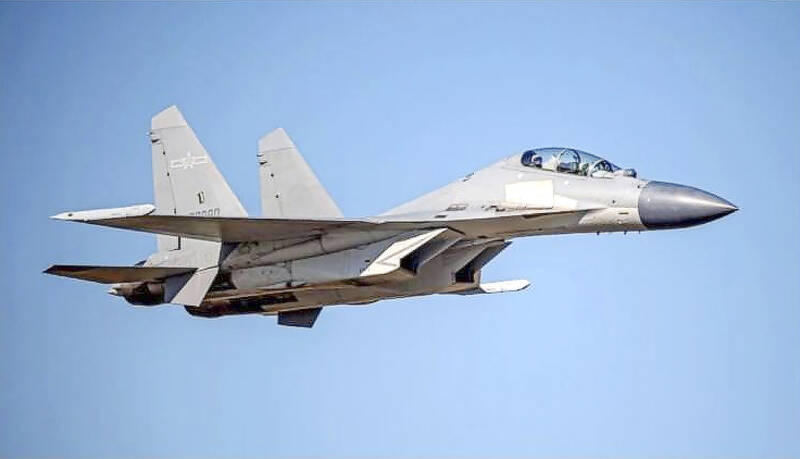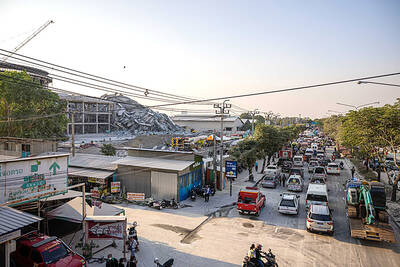The Presidential Office yesterday condemned continued Chinese military activity around Taiwan, after 28 People’s Liberation Army (PLA) aircraft crossed the median line of the Taiwan Strait within 24 hours.
From 6am on Sunday to 6am yesterday, the PLA deployed 57 aircraft and four navy vessels near Taiwan, the Ministry of National Defense said.
Twenty-eight of the aircraft crossed the median line of the Strait and entered the nation’s southwest air defense identification zone.

Photo: Taiwan Ministry of Defense via AP
They included two Sukhoi Su-30 fighter jets, 12 J-16 multipurpose fighters, two J-10 jets and two BZK-005 uncrewed aerial vehicles (UAVs), a ministry map showed.
There were also two nuclear-capable H-6 bombers and one BZK-005 UAV that flew around Taiwan into southeastern airspace before turning back.
The PLA’s Eastern Theater Command in a statement described the actions as “joint combat readiness patrols and actual combat drills.”
It was the PLA’s second major incursion within a month, after it on Dec. 25 and Dec. 26 deployed 71 aircraft around Taiwan — 47 of which crossed the median line — as well as seven warships.
Presidential Office spokesman Xavier Chang (張惇涵) responded to the activity with “strong condemnation.”
He also reiterated that Taiwan’s well-established stance is to avoid escalation and refrain from provoking disputes.
Beijing uses any kind of baseless charge to continue its military activity around Taiwan, Chang said, adding that peace and stability in the Strait is the joint responsibility of both sides.
However, the nation would resolutely defend its sovereignty and security, and protect democracy and freedom, he said.
The ministry in a statement said that it uses aircraft, ships and shore-based missile systems to closely monitor and respond to PLA activity.
Military personnel are also trained for war preparedness based on the principle of no escalation and no provocation, it said.
These latest drills were likely intended to intimidate the US against implementing Taiwan-friendly sections of a recently passed defense spending bill, said Chieh Chung (揭仲), an associate research fellow at the National Policy Foundation think tank.
US President Joe Biden last month signed into law the National Defense Authorization Act for Fiscal Year 2023, which includes up to US$10 billion in security assistance to Taiwan over five years and fast-tracked weapons procurement.
Recent PLA exercises have been relatively insignificant in military terms, Chieh said.
In Sunday’s exercises and those on Friday and Dec. 31, the PLA craft turned back shortly after crossing the median line, showing that the moves are intended to exert political pressure, he said.
The exercises likely serve to remind Washington that if it fails to seriously consider Beijing’s stance on cross-strait matters, there can be no effective “guardrails” against conflict, Chieh said.
At the same time, Beijing is seeking to normalize incursions across the Strait’s median line, which until August last year was tacitly accepted as a demarcator and rarely crossed, Chieh said.
By eroding Taiwan’s defensive space, Beijing is seeking to minimize its early-warning time, he said.
The two H-6 bombers and accompanying UAV traveling into airspace southeast of Taiwan appeared to be a practice run for long-distance joint combat capabilities under the direction of a KJ-500 airborne early warning and control plane stationed inside Taiwan’s southwest air defense identification zone, he said.
Chieh said that the PLA is likely to continue sending long-distance UAVs to conduct reconnaissance for strike fleets, and potentially serve as a guide for long-distance precision ammunition.

AIR SUPPORT: The Ministry of National Defense thanked the US for the delivery, adding that it was an indicator of the White House’s commitment to the Taiwan Relations Act Deputy Minister of National Defense Po Horng-huei (柏鴻輝) and Representative to the US Alexander Yui on Friday attended a delivery ceremony for the first of Taiwan’s long-awaited 66 F-16C/D Block 70 jets at a Lockheed Martin Corp factory in Greenville, South Carolina. “We are so proud to be the global home of the F-16 and to support Taiwan’s air defense capabilities,” US Representative William Timmons wrote on X, alongside a photograph of Taiwanese and US officials at the event. The F-16C/D Block 70 jets Taiwan ordered have the same capabilities as aircraft that had been upgraded to F-16Vs. The batch of Lockheed Martin

GRIDLOCK: The National Fire Agency’s Special Search and Rescue team is on standby to travel to the countries to help out with the rescue effort A powerful earthquake rocked Myanmar and neighboring Thailand yesterday, killing at least three people in Bangkok and burying dozens when a high-rise building under construction collapsed. Footage shared on social media from Myanmar’s second-largest city showed widespread destruction, raising fears that many were trapped under the rubble or killed. The magnitude 7.7 earthquake, with an epicenter near Mandalay in Myanmar, struck at midday and was followed by a strong magnitude 6.4 aftershock. The extent of death, injury and destruction — especially in Myanmar, which is embroiled in a civil war and where information is tightly controlled at the best of times —

China's military today said it began joint army, navy and rocket force exercises around Taiwan to "serve as a stern warning and powerful deterrent against Taiwanese independence," calling President William Lai (賴清德) a "parasite." The exercises come after Lai called Beijing a "foreign hostile force" last month. More than 10 Chinese military ships approached close to Taiwan's 24 nautical mile (44.4km) contiguous zone this morning and Taiwan sent its own warships to respond, two senior Taiwanese officials said. Taiwan has not yet detected any live fire by the Chinese military so far, one of the officials said. The drills took place after US Secretary

THUGGISH BEHAVIOR: Encouraging people to report independence supporters is another intimidation tactic that threatens cross-strait peace, the state department said China setting up an online system for reporting “Taiwanese independence” advocates is an “irresponsible and reprehensible” act, a US government spokesperson said on Friday. “China’s call for private individuals to report on alleged ‘persecution or suppression’ by supposed ‘Taiwan independence henchmen and accomplices’ is irresponsible and reprehensible,” an unnamed US Department of State spokesperson told the Central News Agency in an e-mail. The move is part of Beijing’s “intimidation campaign” against Taiwan and its supporters, and is “threatening free speech around the world, destabilizing the Indo-Pacific region, and deliberately eroding the cross-strait status quo,” the spokesperson said. The Chinese Communist Party’s “threats